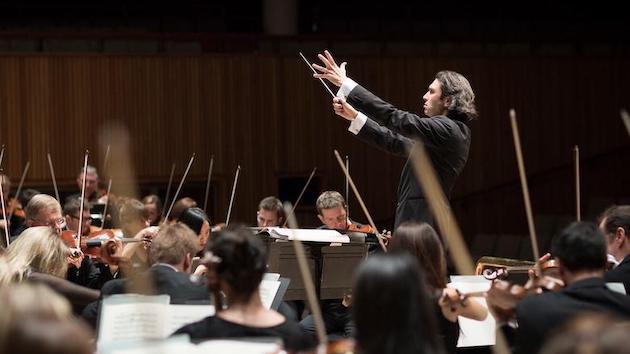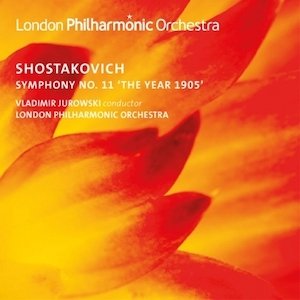
Shostakovich’s Symphony No. 11 (“The Year 1905”) — recorded live last December by Vladimir Jurowski and the London Philharmonic on the orchestra’s own label — was once a neglected also-ran in his cycle of fifteen symphonies. There were reasons for that, but not good reasons.
When the Eleventh was unveiled in 1957 during the Khrushchev “thaw,” Soviet and Western authorities heard it as a graphic musical illustration of the unsuccessful 1905 uprising in St. Petersburg against Czar Nicholas II. To the Soviets, it was a patriotic diorama of events that would eventually lead to the “glorious” 1917 Bolshevik Revolution. To the West, it was a propaganda piece of superficial value, little more than a film score in search of a film — not to mention its refusal to conform to the fashionable twelve-tone ideology of the day.
 I consider it to be a deeply-felt, magnificently-constructed thriller on par with the best of Shostakovich. As in so much Shostakovich, there is a subversive subtext in the music. The symphony’s quiet brooding depiction of the empty Palace Square, the brutal suppression of demonstrators by the Czar’s soldiers on Bloody Sunday, the mourning of the dead, and the alarm raised for future resisters of tyranny can be easily applied to subsequent historical events like the 1956 Hungarian uprising that might have inspired the piece, the 1968 Soviet invasion of Czechoslovakia, or the 1989 Tiananmen Square massacre in China. Shostakovich’s teenaged son Maxim reportedly asked his father at a dress rehearsal — “Papa, what if they hang you for this?”
I consider it to be a deeply-felt, magnificently-constructed thriller on par with the best of Shostakovich. As in so much Shostakovich, there is a subversive subtext in the music. The symphony’s quiet brooding depiction of the empty Palace Square, the brutal suppression of demonstrators by the Czar’s soldiers on Bloody Sunday, the mourning of the dead, and the alarm raised for future resisters of tyranny can be easily applied to subsequent historical events like the 1956 Hungarian uprising that might have inspired the piece, the 1968 Soviet invasion of Czechoslovakia, or the 1989 Tiananmen Square massacre in China. Shostakovich’s teenaged son Maxim reportedly asked his father at a dress rehearsal — “Papa, what if they hang you for this?”
Two excellent recordings were made in the West the year after the premiere by Leopold Stokowski — who seemed to get the subtext immediately in an extraordinarily dramatic performance with his Houston Symphony — and André Cluytens in Paris on a weird three-sided LP set, with the composer supervising the latter during one of his rare trips to the West. Thereafter, Western record labels ignored the Eleventh for decades, save for dodgy-sounding imports from Russia. Only some years after Shostakovich’s alleged memoirs, Testimony, came out did the Eleventh find its place in the repertory, and the atmospheric use of the first movement in a very different context in Carl Sagan’s popular Cosmos television series boosted its visibility as well.
Unlike many of the most gripping recordings of the Eleventh — among them a 1967 Czech Radio broadcast from Yevgeny Mravinsky and the Leningrad Philharmonic that hurtles along with nervous tension and enormous drive; an emotional rendition by Shostakovich disciple Mstislav Rostropovich and the London Symphony; or more recently, Andris Nelsons’s electrifying rendition with the Boston Symphony — Jurowski’s takes its time to make a real impact. He conjures the bare minimum amount of quiet, tense atmosphere in the first movement, observing the note values carefully at a somewhat hurried pace. The furious second movement massacre on the Palace Square makes only a moderate impact here, and Jurowski spends the third movement mourning matter-of-factly.
Later, Jurowski stands up for the composer where it counts, at the opening of the fourth movement, pacing it at a real Allegro non troppo (not too fast) clip, very close to the quarter note = 120 metronome mark. Many take this opening tempo too quickly, including Cluytens (apparently the composer didn’t mind or just didn’t protest). Yet taking the metronome mark literally allows the powerful cello-bass passages room to register with more rhythmic force and drive, accelerating cleanly to the marked Allegro a few pages later. From this point on, the performance gains in intensity and power — even the sound in London’s Royal Festival Hall seems to improve — and it ends with a blazing, driving coda.
Hear this Shostakovich Eleventh, but also hear some of the others mentioned above in order to get an all-encompassing view on what this great symphony has to say. The cloud makes it easier than ever.






